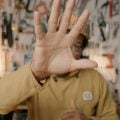Durable Water Repellency Treatments
 You’ve probably seen high-end fly fishing clothing advertised with “100 DWR” or “30 DWR” ratings lately. What is this, some esoteric new ‘guy version’ of Egyptian cotton thread count? Actually, it’s a measure of the number of washes the garment’s “durable water repellency” treatment can take. DWR is what makes water bead up on (rather than soaking out) your high-end garments.
You’ve probably seen high-end fly fishing clothing advertised with “100 DWR” or “30 DWR” ratings lately. What is this, some esoteric new ‘guy version’ of Egyptian cotton thread count? Actually, it’s a measure of the number of washes the garment’s “durable water repellency” treatment can take. DWR is what makes water bead up on (rather than soaking out) your high-end garments.
Ned Hutchinson of Cloudveil explained DWR to me as being “like a forest.” On a molecular level, the DWR coating has a series of tiny, round, water-repellent spheres, which make up a “canopy.” The canopy stands above the exterior layer of the breathable fabric on a set of tiny “trunks,” just like a forest. When a droplet of liquid water hits the DWR treatment, it gets caught in the “leaves” of the canopy and cannot penetrate to the actual fabric, making water bead up.
 In short, this DWR coating is like a layer of Scotchgard (actually itself an early DWR treatment) built into the fabric. In the last few years, DWR coatings have been improved; instead of 12 washes, they can now take 30 or even 100 before they break down. You’ll know your DWR coating has begun to fail when you see “wet out” or dark splotches on your breathable fabric. The best way to prevent this is to keep the garments (including waders!) clean. Follow manufacturers’ instructions to prevent dirt and grime from breaking down your “forest canopy,” thereby making your breathables stay drier longer.
In short, this DWR coating is like a layer of Scotchgard (actually itself an early DWR treatment) built into the fabric. In the last few years, DWR coatings have been improved; instead of 12 washes, they can now take 30 or even 100 before they break down. You’ll know your DWR coating has begun to fail when you see “wet out” or dark splotches on your breathable fabric. The best way to prevent this is to keep the garments (including waders!) clean. Follow manufacturers’ instructions to prevent dirt and grime from breaking down your “forest canopy,” thereby making your breathables stay drier longer.
Do you lather up in TurtleWax before fishing in the rain? Know of a better way to prevent wet out? Let us know in the Comments section!
Gear: Wet Wading Combos
Overlooked Gems #3: Zip Ties











